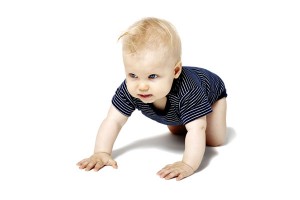Join the thousands of parents already raising smarter, happier babies with our online baby classes: The Active Babies Smart Kids series. Click here.
GymbaROO-KindyROO kids are excelling academically, emotionally, in leadership roles and on the sporting field. Find us at: GymbaROO-KindyROO
Dr Jane Williams and Bindy Cummings
Bottom shuffling has been suggested by some as an acceptable ‘alternative means of getting around’. At GymbaROO-KindyROO we suggest that the natural developmental pathway for motor skills does not normally include bottom shuffling, rather bottom shuffling is a baby’s desperate means of mobility when, for one reason or another, he has not been able to crawl and creep. There are developmental advantages to crawling and creeping which assist with later motor and learning skills that bottom shufflers may miss out on. More on crawling here. The reasons for bottom shuffling may include something as simple as ‘the floor is too hard’ or lack of opportunity to crawl, or it may be as complex as the lack of inhibition of the primitive reflexes.
Reasons why babies may bottom shuffle or crawl with one leg dragging behind or tucked under their bodies
1. Environmental opportunities/experiences
a) Hard floors or thick carpets. Sometimes babies really want to crawl and creep, however hard, tiled or wooden floors may hurt their knees! Alternatively some babies find commando crawling challenging on thick carpet – there is just too much friction, so they give up trying.
b) Babies who spend most of their awake time on their backs can experience difficulties when it comes to crawling and creeping. On their backs, babies do not have to work against gravity, so they do not develop the necessary muscle tone and strength to push and pull themselves along, nor to get their body up off the ground.
c) Babies propped to sit from an early age miss many opportunities to lie on their tummies, push along and then get up on all fours. We are born to move and if the first way we learn to move around is bottom shuffling, then that’s what we do! This is, most likely, the main reason for bottom shuffling today. Propping babies to sit too early has many developmental consequences – especially in the areas of muscle tone development, primitive reflex inhibition and the development of postural reflexes.
Read about when to sit your baby up here.
Read why we do not recommend ‘baby seats’ here.
2. Neurological development
Babies and young children need movement opportunities and practice to fully control the primitive reflexes with which they are born. Any ‘retained reflexes’ can interfere with later learning and development. The activation and then inhibition of primitive reflexes is essential to providing the platform for higher neurological skills. Babies who do not fully activate their primitive reflexes cannot fully inhibit (control) them. Many babies that bottom shuffle or drag a leg will still have not fully integrated the following primitive reflexes: TLR, ATNR and/or STNR. Access our online video on primitive reflexes here.
a) Uninhibited TLR or poorly developed TLR in extension. The TLR causes a baby to reflexively curl up into flexion when the head is down and stretch out into extension when the head is back. A normal delivery activates the TLR in extension as the baby has to extend fully to move down the birth canal. Lying on the tummy in the early months of life helps further integrate the TLR. If a baby has the TLR reflex present, he will struggle to crawl.
b) Uninhibited ATNR. The ATNR is the primitive reflex that occurs when a young baby is  lying on his back and the head is turned to either side. If the head is turned to the left, the left arm and left leg straighten and the right arm and right leg bend, and visa versa. If this reflex is still present when a baby tries to creep, then you can see why the leg may bend up under the body. Watch a bottom shuffler shuffle, they often only use one leg to get around, the other leg just drags along – this is because the unused leg cannot be bent voluntarily.
lying on his back and the head is turned to either side. If the head is turned to the left, the left arm and left leg straighten and the right arm and right leg bend, and visa versa. If this reflex is still present when a baby tries to creep, then you can see why the leg may bend up under the body. Watch a bottom shuffler shuffle, they often only use one leg to get around, the other leg just drags along – this is because the unused leg cannot be bent voluntarily.
 c) Uninhibited STNR. This reflex helps get a baby up onto all fours, however it needs to be inhibited if the baby is to move forward. To inhibit this reflex, a baby will rock backward and forward and shake their head. If the STNR is not inhibited, the baby will not be able to move forward on all fours and he may use bottom shuffling or go straight to walking, as these are the only ways he can get around.
c) Uninhibited STNR. This reflex helps get a baby up onto all fours, however it needs to be inhibited if the baby is to move forward. To inhibit this reflex, a baby will rock backward and forward and shake their head. If the STNR is not inhibited, the baby will not be able to move forward on all fours and he may use bottom shuffling or go straight to walking, as these are the only ways he can get around.
Ask your GymbaROO-KindyROO instructor if you would like to know more about these reflexes and their inhibition. Read more here.
d) Babies who experience a traumatic birth may also be at risk of not being able to inhibit primitive reflexes easily, as their brain cells (neurons) may have been bruised or slightly damaged and this can delay or impede maturation. They may present with low muscle tone and may also experience ‘structural hurt’, especially in the shoulders or hips. These two areas are particularly important for creeping.
e) Muscle tone. Babies with low muscle tone will be more likely to bottom shuffle rather than crawl if they are not given ample tummy time and other important movement experiences. Babies need to lie on their tummies to stimulate the proprioceptive sensors in their muscles and joints. They need to be able to lift their heads and shoulders up off the mat against gravity to stimulate increasing muscle tone and strength. In this position they will also strengthen their toes, feet and legs as they kick against the floor. Read more on muscle tone here.
How to avoid bottom shuffling
Be sure to do your GymbaROO/KindyROO activities at home during the week.
- Lots of tummy time. Free online video on tummy time here.
- Lots of baby massage to stimulate proprioceptor senses in the muscles and joints. Access to baby massage video here.
- Provide many movement opportunities – in particular, baby exercises that stimulate the joints and muscles. Access to baby exercise video here.
- Regularly play games that involve vestibular stimulation; slow spinning, rocking, rolling etc. – this stimulates the cerebellum, important for muscle tone and the inhibition of primitive reflexes. Access to vestibular ideas and games here.
- If the home floors are all hard surfaces, make some ‘knee pads’ for your baby. If the home floors are covered in thick carpets, buy a roll of vinyl to put on the floor.
What to do if you have a bottom shuffler or leg-dragging crawler
- Don’t panic! There are lots of ways to help encourage your baby towards the correct crawling and creeping movement patterns.
- We highly recommend a visit to a paediatric physiotherapist or osteopath. This can make a huge difference as hips or shoulders can be ‘freed up’ to move. The primitive reflexes cannot easily be inhibited, nor the postural reflexes activated if there are structural issues.
- Encourage your child onto his tummy. Lie down too, to help keep him entertained.
- If your child is a crawler with a leg drag, place your baby in the all fours position and gently rock him backwards and forwards. You can also bounce your baby gently on the trampoline while on all fours. Rocking from side to side at the hips also assists in the inhibition of reflexes.
- Lot of baby exercises – hip rotations, knee bends, ankle bends, leg extension and flexion etc.
- Roll your baby from side to side – this helps free up the hip area, as well as providing vestibular stimulation. You can do this on a mat or on a large ball. See how to do this here.
- Regularly play games that involve vestibular stimulation.
- Each time your baby starts to bottom shuffle, alter his position back to the tummy or on all fours to help him out of the habit. Be sure not to be stressed about it and offer lots of praise and encouragement. Access to video on crawling and creeping here.
- Ask your GymbaROO-KindyROO instructor for more advice and activities.
Dr Jane Williams (PhD, BMgt, RN(Paeds)) is the Research and Education General Manager for GymbaROO and KindyROO. Dr Williams is one of Australia’s leading experts on baby and child development. More on Dr Williams here.
Bindy Cummings (B.Ed(Human Movement) Hons) has worked as a teacher, child development consultant, early childhood development lecturer, teacher trainer and INPP & iLS consultant. She is the co-creator of GymbaROO’s Active Babies Smart Kids online series, has authored many published articles on child development. She is working on the content and development GymbaROO’s portal and online training programs, and the creation of new online programs for parents and children. More on Bindy Cummings here.
GymbaROO-KindyROO
Thousands of parents, babies and children are presently involved in our programs and creating rising stars. GymbaROO-KindyROO kids are excelling academically, emotionally, in leadership roles and on the sporting field. Come join all the fun and learning! “GymbaROO – The best decision I ever made for my child.” Classes from 6 weeks old – 7 years GymbaROO KindyROO
Active Babies Smart Kids – Online Baby Classes
GymbaROO-KindyROO’s online series of baby classes is taking the parenting world by storm! It is highly recommended by doctors, paediatricians, early childhood experts and the Maternal Child and Family Health Nurses Association. This series is being called: “The essential guide for parents”. Join the thousands of parents already playing with their babies from birth, in the best way for brain and body development and laying crucial foundations for future learning. What happens in the first year, not only matters, it matters a lot! See Introductory video below.
Active Babies Smart Kids online series – Click here.
Try the first class FREE! Click here to watch our Active Babies Smart Kids Episode 1 – Tummy Time
Enjoy the following GymbaROO-KindyROO articles
GymbaROO-KindyROO: Who, what, where, why and how
All about GymbaROO-KindyROO’s online baby classes for parents and babies: Active Babies Smart Kids
How to raise a smarter, happier baby
Why active babies make smart kids
Become a GymbaROO-KindyROO franchisee
Why creeping and crawling matter.
‘Baby Seat’ devices and propping your baby to sit. Please avoid. This is why.
Terrifically toned: Muscle tone and its link to learning and development in babies and children.
Music and your child’s developing brain: Research news.
An important warning for all parents of babies.
Primitive reflexes and why parents need to know about them.
The benefits of dancing with your baby.
Click here for more GymbaROO-KindyROO article choices

